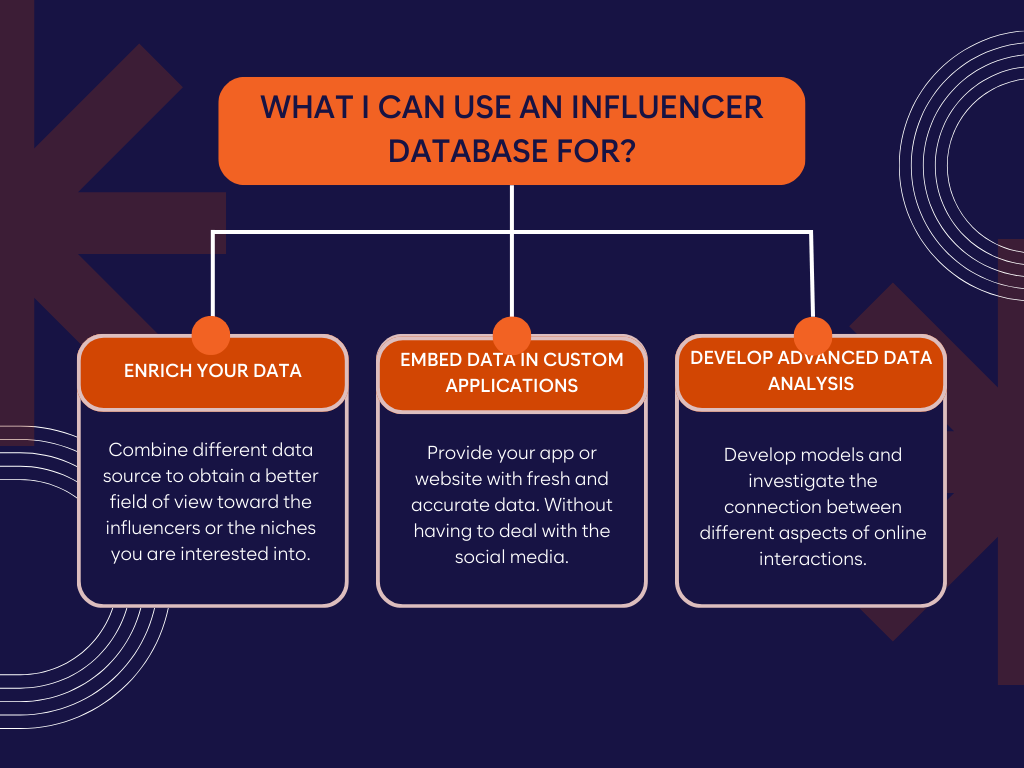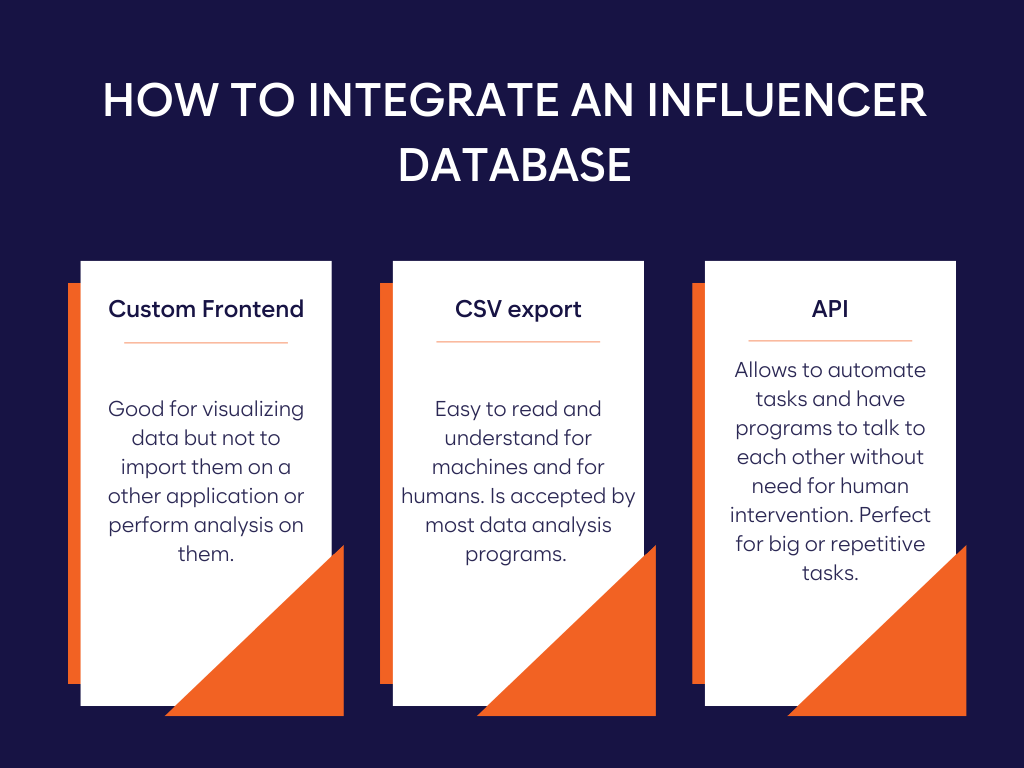If you are a marketer looking at influencer marketing, a CEO with an idea that targets influencers, or just interested in the dynamics that involve content creators, you most likely need access to an influencer database!
Adding an influencer database to your tool bag can be beneficial for all these purposes and even more. Businesses often need access to information regarding influencers and the creator economy that are contained in an influencer database
In this article we will go over what an influencer database is, what can you find in it, and how that can help you. Plus, we will go over free alternatives and ways around using a professionally managed database.
What is an influencer database?
An influencer database is an organized collection of influencers, generally, it also includes information and analytics like their following, engagement, and social media they are active on, plus many other things.
Influencer databases allow marketers to bypass the choke points of social media by having more precise and in-depth search functions. Oftentimes a database is populated with data from different social media making it easier and faster to check between platforms.
Influencer databases gather their data from social media and they can supplement it with other services and tools to provide better contextualization and deeper analytics.
Is there a database of all influencers?
It is unlikely that exists a database of all influencers. Even if reputable services scan social media and update their database daily, the amount of data to go through and categorize is just way too large and too fast-changing.
Are there free tools to find influencers?
Of course, mainly social media themselves. All social media platforms allow you to search the profiles of their users but then is up to you to find the ones that fit your needs.
Social media do not let you search for the following size, engagement rate, and often neither just topics. Therefore, the quality of the results may vary depending on your knowledge of the niche you are interested in.
How can I find influencers in bulk?
To find as many influencers that fit specific criteria, it is best to use professional tools. Advanced search functions, like the CreatorDB’s, allow you to quickly highlight the creators for you based on measures like following, content category, language, country of provenance, and even audience demographics.
With these services, you will be able to access the right influencers at a much larger scale than on social media, also having an easier time comparing them.

Find Your
Perfect Influencer
Match Instantly
How I get an influencer database?
There are two ways to get an influencer database:
- Building your own
- Using a professional service
While building your own database can sound enticing, it would bring you to deal with many chokepoints that social media put in place when accessing their data. By relying on a professional service, you can rest assured that all those bottlenecks will be addressed by an expert team allowing you to access all the information you need hassle-free.
Access an influencer database
Getting access to an existing influencer database is fairly simple, in fact, you can try CreatorDB’s one with just an easy sign-up. Many of these services allow for free trials so that you can try them first-hand and evaluate their usefulness.
There are mainly two ways to interface with an influencer database:
- Through a custom user interface created by the database owner
- Using an API key provided by the database owner
According to your needs, it can be advantageous to use one method over the other.
How to search through an influencer database?
Influencer databases can be searched using many different criteria. Commonly marketers look for influencers that are popular in specific content categories or geographies. This can be easily sorted out by querying a database for these data. Some databases, like CreatorDB, also provide audience data and allow you to search for creators with audiences of specific ages or located in particular countries.
Databases or portals
Differently from databases influencer portals are directly connected with the creators they feature. Often they offer more detailed information about the influencer’s performances, but the number of influencers present drops significantly.
Portals work as a sort of agency facilitating communication between the two parts but like agencies their reach is limited. Often portals only feature medium-large influencers and don’t include micro-influencers hampering the efficacy of your campaign.
What I can use an influencer database for?
The beauty of influencer databases is that they are extremely versatile and can be used for a variety of different purposes. From our experience, these are the most common use cases for an influencer database:
Enrich previously acquired data
Companies often combine data from third-party providers with data they collect themselves in order to obtain a more nuanced understanding of the situation around the influencers they are interested in.
Embed extra data for custom applications
Many of our clients need access to just a minute part of our data offering in order to integrate it with their products. For example, a website that shows the subscriber count for Instagram profiles will likely obtain access to a third-party database and acquire the data from there over directly collecting the data.
Develop advanced data analysis
For some the data they can retrieve from third-party a provider are just the starting point. They will use them to develop models and investigate the connection between various aspects of online interactions.
Learn how Talkback sped up the identification of fitting creators thanks to the creator comment-reply ratio in our case study.

How can I find Influencer analytics?
Influencer databases generally include most common, and some uncommon, analytics, making them available for any user.
Can I find influencer data for free?
Of course, most influencers’ data are freely available on social media. You could collect data regarding likes, followers, and much more by yourself for free. But would it be worth the hassle? Most likely not, that’s why relying on a professional third party is often the best option.
How can I find influencers’ contact information?
Contact information is some of the most searched and most difficult to find information on influencers’ databases. While many do include them others don’t and is something you will have to verify yourself.
You can avoid all the trouble and rely on CreatorDB, we provide contact information.
Common analytics in influencer databases
Most if not all influencer databases will include:
- Engagement Rate
- Followers count, sometimes with the progression over time
- Views, especially for YouTube channels
- Average likes
- Average comments
Many databases will also provide additional analytics. Often more advanced ones are derived by performing calculations on the basic ones or contextualizing the values with other creators in the same category or in the database.
Audience analytics
Some databases, like CreatorDB, provide you with audience data. Since these data are only visible to the creators themselves they are often derived with alternative means and represent an approximation. They may include:
- Audience countries of origin
- Split between male and female in the audience
- Split between age groups in the audience
While not a hundred percent accurate audience analytics allow marketers to better understand if a content creator is a good fit for their goals or not.

Find Your
Perfect Influencer
Match Instantly
How to integrate an Influencer Database with my workflow?
Data providers are going to offer different ways to interact with their data and you may prefer some to others due to your necessities.
Custom frontend
Many data providers are quite jealous of their data and only allow you to access them through a custom portal that will show all the data but prevent you from bulk exporting them in any form. If you choose to rely on a provider that only offers this option be ready to manually copy data one by one when you need them.
CSV export
A common form to allow data export is through CSV files. You are probably already familiar with this format of data and can be easily imported into most data analysis programs. It still requires some manual work in downloading the spreadsheets and importing them to their destination.
API
Not very common but extremely powerful. API allows machines to talk directly and retrieve data by simple code.
By querying a data provider server the data you need will be delivered to you, typically as JSON, and your application will be able to directly pick them up and parse them without any need for human intervention.
API is the best implementation for big or repetitive tasks since they can be set up once and executed in perpetuity.





